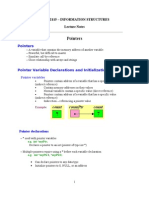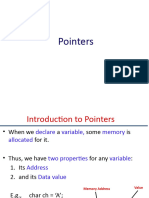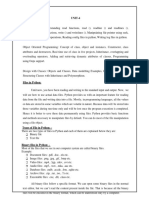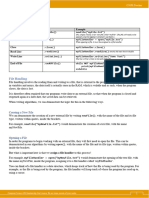0% found this document useful (0 votes)
65 views39 pagesC++ Pointers
Pointer variables store memory addresses and can be used to indirectly access and modify the value of another variable. A pointer must be declared with a type (e.g. int*) and is initialized using the address-of operator (&). Pointer arithmetic and dereferencing operator (*) allow manipulating data at the address stored in a pointer. Arrays can also be accessed using pointers by treating array names as pointers to their first element. Multiple levels of indirection are possible but excessive indirection reduces readability. Pointers are commonly used to pass arguments by reference and implement dynamic data structures in C++.
Uploaded by
Jonathan BroquezaCopyright
© © All Rights Reserved
We take content rights seriously. If you suspect this is your content, claim it here.
Available Formats
Download as PDF, TXT or read online on Scribd
0% found this document useful (0 votes)
65 views39 pagesC++ Pointers
Pointer variables store memory addresses and can be used to indirectly access and modify the value of another variable. A pointer must be declared with a type (e.g. int*) and is initialized using the address-of operator (&). Pointer arithmetic and dereferencing operator (*) allow manipulating data at the address stored in a pointer. Arrays can also be accessed using pointers by treating array names as pointers to their first element. Multiple levels of indirection are possible but excessive indirection reduces readability. Pointers are commonly used to pass arguments by reference and implement dynamic data structures in C++.
Uploaded by
Jonathan BroquezaCopyright
© © All Rights Reserved
We take content rights seriously. If you suspect this is your content, claim it here.
Available Formats
Download as PDF, TXT or read online on Scribd
/ 39



















































































